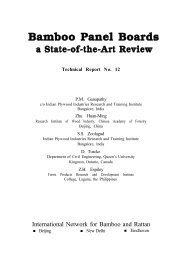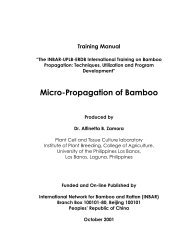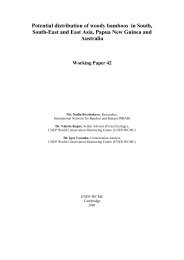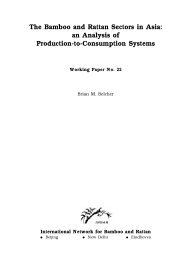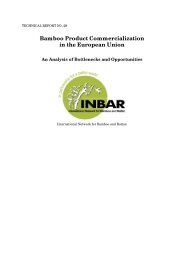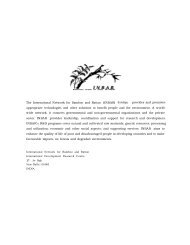ISSN ………… - International Network for Bamboo and Rattan
ISSN ………… - International Network for Bamboo and Rattan
ISSN ………… - International Network for Bamboo and Rattan
You also want an ePaper? Increase the reach of your titles
YUMPU automatically turns print PDFs into web optimized ePapers that Google loves.
4.3. Bleaching<br />
The object of bleaching is to render the pulp whiter without excessive degradation of the cellulose.<br />
Industrial bleaching of pulps first with hypochlorite <strong>and</strong> later with chlorine, partly in combination, <strong>and</strong><br />
with an intermediate extraction step with alkali began at the end of the 19 th century. The development<br />
of pulp bleaching techniques in the 20 th century has led to a large number of bleaching chemicals<br />
(Appendix 6A) applied in numerous <strong>and</strong> highly specific processes (Appendix 6B, C, D & E) today.<br />
The principal aim of pulp bleaching is to increase brightness. The whiteness of pulps is generally<br />
determined by measuring the reflectance of nearly monochromatic light (457 microns) by a st<strong>and</strong>ard<br />
General Electric (GE) reflectance meter. A magnesium oxide plate of known reflectance is used as a<br />
st<strong>and</strong>ard. The brightness values are expressed as percentage of light reflected by the sample as<br />
compared with that reflected by a completely white surface. Unbleached pulps generally exhibit<br />
brightness values ranging from 25-65 GE units. The sulphite process usually gives the brightest<br />
unbleached pulps, whereas those produced by kraft, soda or semichemical processes can be quite<br />
dark. Groundwood pulps have brightness values in between 40 <strong>and</strong> 60 units.<br />
To produce white fibres from the brown or pale yellow pulps, treatment with a bleaching agent is<br />
required. The nature of the bleaching operation depends on several factors: the type of raw material<br />
used to make the pulp, the pulping process, the degree of whiteness desired, <strong>and</strong> the purpose <strong>for</strong><br />
which the pulp is to be used. Bleaching carries further the fibre purification accomplished in the<br />
pulping process. As the light-absorbing chromophoric component in unbleached pulps are<br />
predominantly functional groups of degraded <strong>and</strong> altered residual lignin, bleaching can be per<strong>for</strong>med<br />
either by converting <strong>and</strong> stabilizing chromophoric groups without loss of substance (ligninpreserving<br />
bleaching) or by removing the lignin (lignin- removing bleaching). The traces of lignin <strong>and</strong><br />
other coloured substances (quinone like substances <strong>for</strong>med from the phenolic groups of lignin by<br />
various oxidative processes are known to absorb visible light) are removed or converted to colourless<br />
<strong>for</strong>ms by bleaching. The extraneous constituents of wood also contribute to the colour of certain<br />
pulps, especially the groundwood pulps. Along with the removal of the residual lignin <strong>and</strong> other<br />
compounds, insufficiently delignified particles (shives, bark specks) are also partly removed.<br />
There<strong>for</strong>e, bleaching can additionally be regarded as a purification process, which is used especially<br />
in the case of dissolving pulp production to obtain a pure pulp with high alpha-cellulose content.<br />
Bleaching without delignification to brightness values above 70 is difficult to achieve. High<br />
brightness is not, of course, the only important characteristic of bleached pulps. A good paper pulp<br />
must also have good strength <strong>and</strong> good papermaking properties, <strong>and</strong> it is important that these<br />
properties are not lost in the bleaching process.<br />
21



